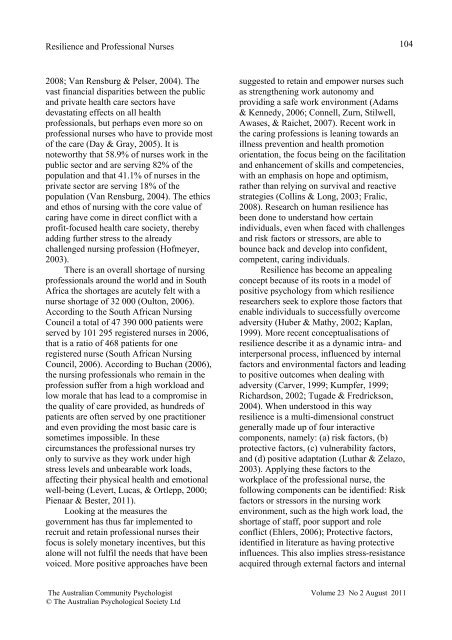The Australian Community Psychologist - APS Member Groups
The Australian Community Psychologist - APS Member Groups
The Australian Community Psychologist - APS Member Groups
You also want an ePaper? Increase the reach of your titles
YUMPU automatically turns print PDFs into web optimized ePapers that Google loves.
Resilience and Professional Nurses<br />
104<br />
2008; Van Rensburg & Pelser, 2004). <strong>The</strong><br />
vast financial disparities between the public<br />
and private health care sectors have<br />
devastating effects on all health<br />
professionals, but perhaps even more so on<br />
professional nurses who have to provide most<br />
of the care (Day & Gray, 2005). It is<br />
noteworthy that 58.9% of nurses work in the<br />
public sector and are serving 82% of the<br />
population and that 41.1% of nurses in the<br />
private sector are serving 18% of the<br />
population (Van Rensburg, 2004). <strong>The</strong> ethics<br />
and ethos of nursing with the core value of<br />
caring have come in direct conflict with a<br />
profit-focused health care society, thereby<br />
adding further stress to the already<br />
challenged nursing profession (Hofmeyer,<br />
2003).<br />
<strong>The</strong>re is an overall shortage of nursing<br />
professionals around the world and in South<br />
Africa the shortages are acutely felt with a<br />
nurse shortage of 32 000 (Oulton, 2006).<br />
According to the South African Nursing<br />
Council a total of 47 390 000 patients were<br />
served by 101 295 registered nurses in 2006,<br />
that is a ratio of 468 patients for one<br />
registered nurse (South African Nursing<br />
Council, 2006). According to Buchan (2006),<br />
the nursing professionals who remain in the<br />
profession suffer from a high workload and<br />
low morale that has lead to a compromise in<br />
the quality of care provided, as hundreds of<br />
patients are often served by one practitioner<br />
and even providing the most basic care is<br />
sometimes impossible. In these<br />
circumstances the professional nurses try<br />
only to survive as they work under high<br />
stress levels and unbearable work loads,<br />
affecting their physical health and emotional<br />
well-being (Levert, Lucas, & Ortlepp, 2000;<br />
Pienaar & Bester, 2011).<br />
Looking at the measures the<br />
government has thus far implemented to<br />
recruit and retain professional nurses their<br />
focus is solely monetary incentives, but this<br />
alone will not fulfil the needs that have been<br />
voiced. More positive approaches have been<br />
suggested to retain and empower nurses such<br />
as strengthening work autonomy and<br />
providing a safe work environment (Adams<br />
& Kennedy, 2006; Connell, Zurn, Stilwell,<br />
Awases, & Raichet, 2007). Recent work in<br />
the caring professions is leaning towards an<br />
illness prevention and health promotion<br />
orientation, the focus being on the facilitation<br />
and enhancement of skills and competencies,<br />
with an emphasis on hope and optimism,<br />
rather than relying on survival and reactive<br />
strategies (Collins & Long, 2003; Fralic,<br />
2008). Research on human resilience has<br />
been done to understand how certain<br />
individuals, even when faced with challenges<br />
and risk factors or stressors, are able to<br />
bounce back and develop into confident,<br />
competent, caring individuals.<br />
Resilience has become an appealing<br />
concept because of its roots in a model of<br />
positive psychology from which resilience<br />
researchers seek to explore those factors that<br />
enable individuals to successfully overcome<br />
adversity (Huber & Mathy, 2002; Kaplan,<br />
1999). More recent conceptualisations of<br />
resilience describe it as a dynamic intra- and<br />
interpersonal process, influenced by internal<br />
factors and environmental factors and leading<br />
to positive outcomes when dealing with<br />
adversity (Carver, 1999; Kumpfer, 1999;<br />
Richardson, 2002; Tugade & Fredrickson,<br />
2004). When understood in this way<br />
resilience is a multi-dimensional construct<br />
generally made up of four interactive<br />
components, namely: (a) risk factors, (b)<br />
protective factors, (c) vulnerability factors,<br />
and (d) positive adaptation (Luthar & Zelazo,<br />
2003). Applying these factors to the<br />
workplace of the professional nurse, the<br />
following components can be identified: Risk<br />
factors or stressors in the nursing work<br />
environment, such as the high work load, the<br />
shortage of staff, poor support and role<br />
conflict (Ehlers, 2006); Protective factors,<br />
identified in literature as having protective<br />
influences. This also implies stress-resistance<br />
acquired through external factors and internal<br />
<strong>The</strong> <strong>Australian</strong> <strong>Community</strong> <strong>Psychologist</strong> Volume 23 No 2 August 2011<br />
© <strong>The</strong> <strong>Australian</strong> Psychological Society Ltd

















